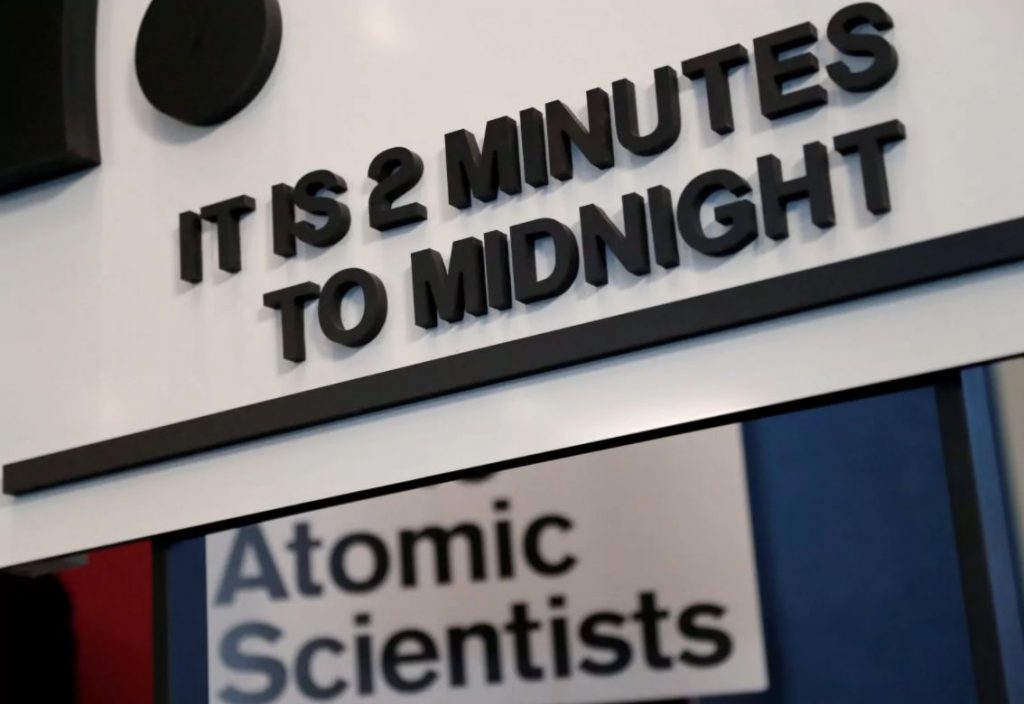“To call the world’s nuclear situation dire is to understaternthe danger and its immediacy,” warned Rachel Bronson, Ph.D., president of thernBulletin of the Atomic Scientists.
Famous forrntheir symbolic Doomsday Clock, the Bulletin’s highly respected scientists andrn15 Nobel Laureate consultants recently moved the clock to two minutes beforernmidnight — warning that a nuclear war catastrophe is very possible!
The onlyrnother time in its seven decade history the minute hand has been set this closernto midnight — that is, the devastation of the planet, and virtually everythingrnand everyone on it — was in 1953 after the U.S. and the Soviet Union testedrnthermonuclear weapons for the first time.
And in lessrnthan three weeks after the Doomsday Clock was moved so perilously close to nuclearrnmidnight, the Pentagon on Feb. 2 released its 2018 Nuclear Posture Reviewrn(NPR), providing the world with even more reasons to be alarmed.
Adding tornthe insane fact that both the United States and the Russian Federation eachrnhave hundreds of nuclear weapons aimed at each other programmed with arn“launch-on-warning” — hair-trigger-alert — status, the NPR states that the U.S.rnwill continue its policy to be the first to initiate a nuclear attack if itrndecides that its “vital interests” and those of its “allies and partners” arernat risk.
I interviewed Beatrice Fihn, executive director of the International Campaign to Abolish Nuclear Weapons, which as an organization won the 2017 Nobel PeacernPrize for its leading work to achieve a nuclear-free world through the U.N. Treaty on the Prohibition of Nuclear Weapons.rn
She said the Pentagon’s NPR furthersrnPresident Trump’s $1 trillion-plus planrnto modernize the U.S. nuclear arsenal, and produce new so-called “low-yield”rnnuclear weapons — similar in destructive power to the atomic bombs dropped onrnHiroshima and Nagasaki — making them more “usable.”
Fihn said,rn“There are no ‘good nukes’ and this policy makes nuclear war more likely.”
Fihn has deeprnadmiration for Pope Francis saying, “The Holy Fatherrnmade it clear last year that the only morally acceptable nuclear strategy isrnone that seeks security through the total elimination of nuclear weapons.”
It is of specialrnnote that the Holy See was one of the first countries to sign and ratify thernTreaty on the Prohibition of Nuclear Weapons. But most unfortunately, the U.S.rnand the other eight nuclear powers have rejected it.
While writing this column, I paused to watchrnthe 1983 movie “The Day After” which realistically portrays how an escalatingrnset of events could quickly lead to a catastrophic nuclear conflict, and thernhorrific aftermath of a nuclear war.
I stronglyrnurge all adults and teenagers to watch this unfortunately still very timely film. And it would be very fruitful if churchrngroups would view it together, followed by prayer, discussion and a commitmentrnto action.
God thernCreator is calling each of us — clergy and laity — to persistently raise ourrnvoices on behalf of humanity and the earth upon which we live — before it’s toornlate!
Thernday before Rev. Martin Luther King, Jr. was assassinated, he prophetically warnedrnus in his compelling “I’ve been to the Mountaintop” speech: “It is no longer arnchoice between violence and nonviolence in this world; it's nonviolence or nonexistence.rnThat is where we are today.”
Tony Magliano is an internationally syndicatedrnsocial justice and peace columnist. He is available to speak at diocesan orrnparish gatherings. Tony can be reached at [email protected].

